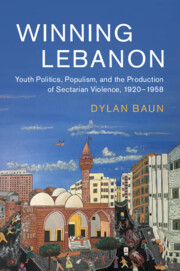Book contents
- Winning Lebanon
- Cambridge Middle East Studies
- Winning Lebanon
- Copyright page
- Dedication
- Epigraph
- Contents
- Figures, Maps, and Tables
- Acknowledgments
- A Note on Conventions
- Introduction
- 1 The Future of Young Men
- 2 Producing Space
- 3 Broadening the Base
- 4 In Defense of Lebanon
- 5 Fighting the Punks
- Epilogue
- Bibliography
- Index
- Books in the Series
1 - The Future of Young Men
The Construction and Performance of Youth Politics
Published online by Cambridge University Press: 16 October 2020
- Winning Lebanon
- Cambridge Middle East Studies
- Winning Lebanon
- Copyright page
- Dedication
- Epigraph
- Contents
- Figures, Maps, and Tables
- Acknowledgments
- A Note on Conventions
- Introduction
- 1 The Future of Young Men
- 2 Producing Space
- 3 Broadening the Base
- 4 In Defense of Lebanon
- 5 Fighting the Punks
- Epilogue
- Bibliography
- Index
- Books in the Series
Summary
Chapter 1 explores the architecture and architects of youth politics in mid-twentieth-century Lebanon. It moves chronologically from the 1920s to 1950s, describing the historical background of multiple popular organizations, and taking an individual group as a means to explore one theme in the construction of youth politics – that is, building a group culture, flair and feel, and organizational capacity among youth-centric organizations. I argue that these groups were collectively the shapers of a distinct manifestation of popular politics in the Middle East, what I refer to as populism. This trend found its earliest expression with the Lebanese People’s Party in the 1920s, continued with youth organizations like the Najjadeh in the 1930s, and culminated with transnational student groups like the Arab Nationalist Youth in the 1950s. Using the source material of these groups, I find that although they were deploying radically different worldviews to win Lebanon, based on the different, competing ideologies of the time – Arab nationalism, Lebanese nationalism, international socialism – there was more continuity than difference between these groups in their early years. They all channeled anger with colonial rule, the complicity of Lebanese elites in this subjugation, and used a discourse of populism to launch public awareness and protest.
- Type
- Chapter
- Information
- Winning LebanonYouth Politics, Populism, and the Production of Sectarian Violence, 1920–1958, pp. 22 - 70Publisher: Cambridge University PressPrint publication year: 2020

